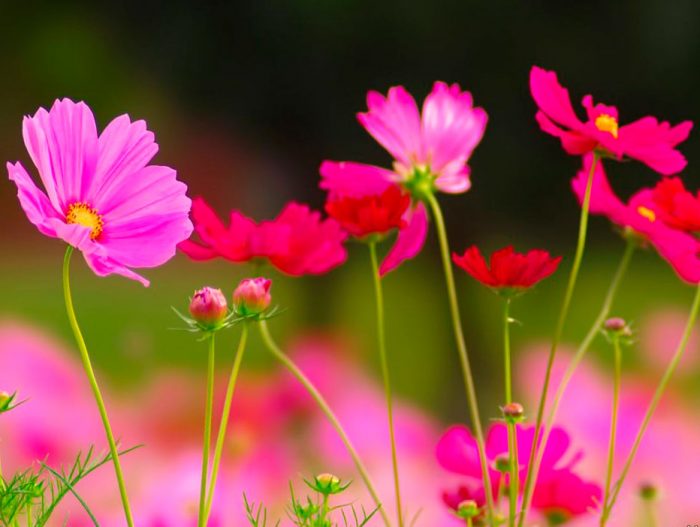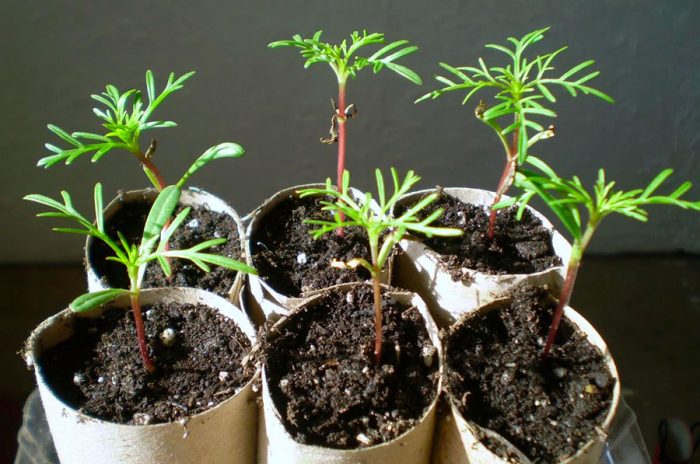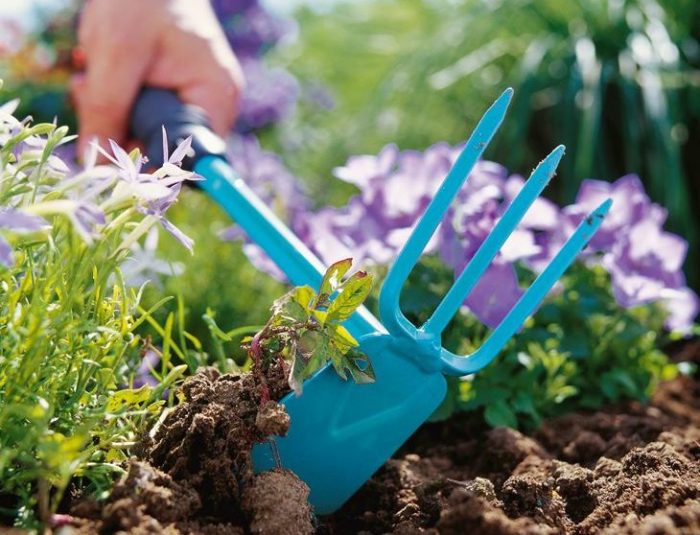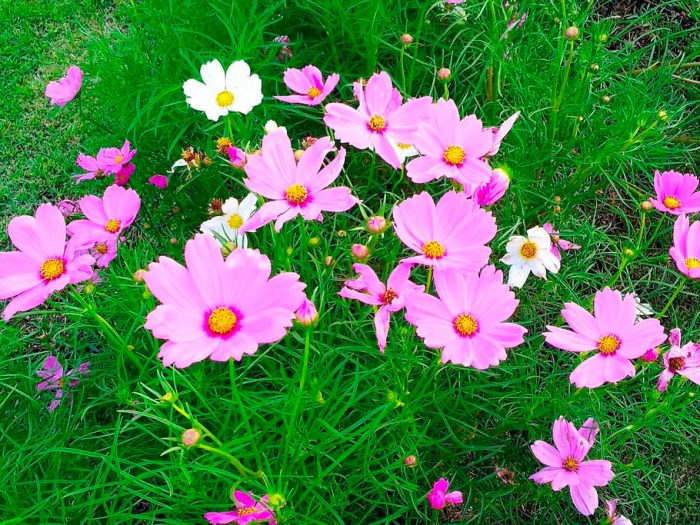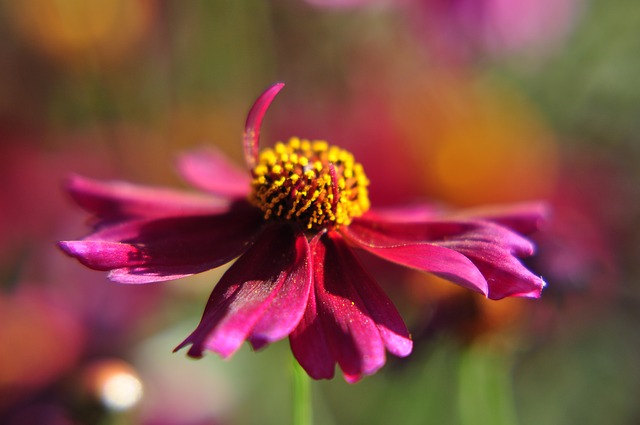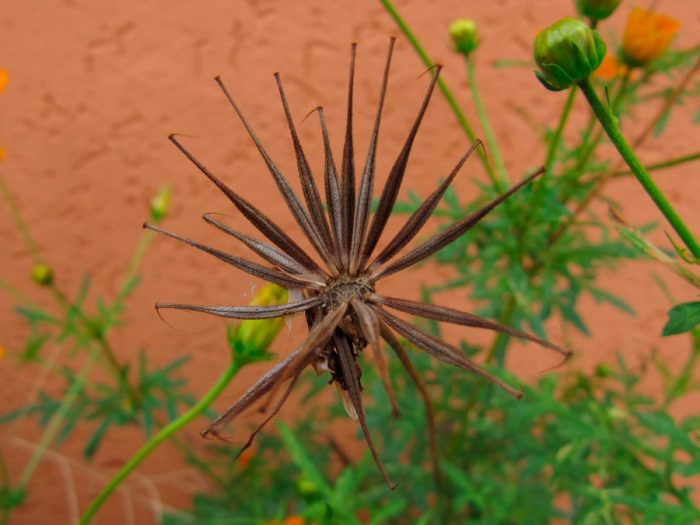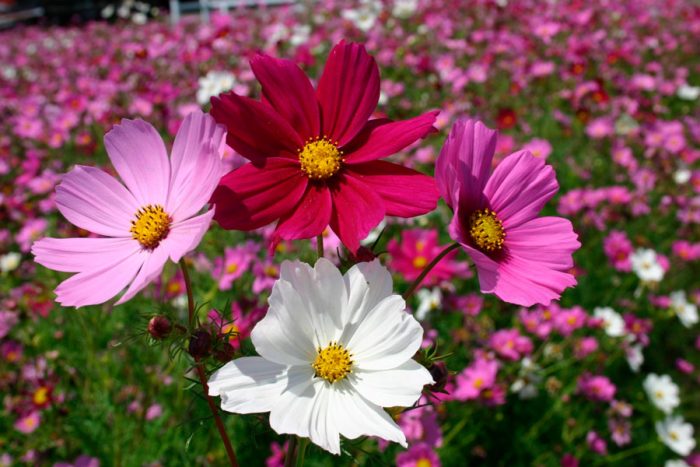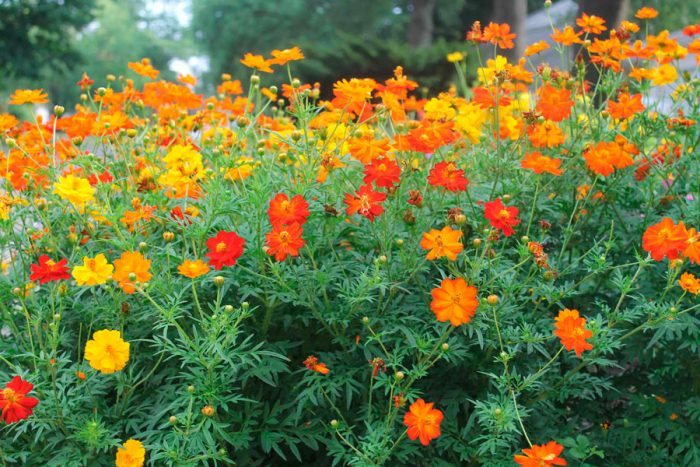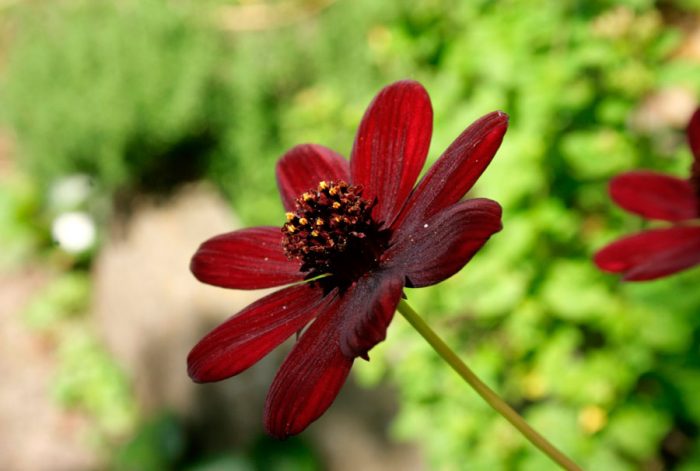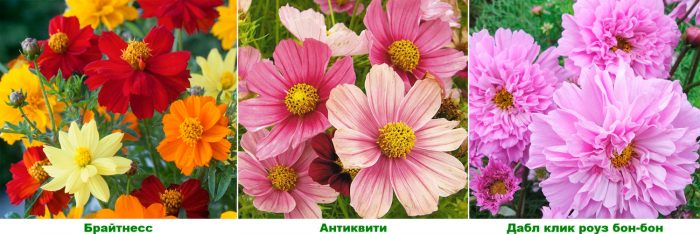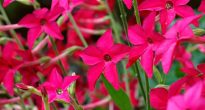The flowering annual or perennial herb kosmeya (Cosmos), also called the Mexican aster, or cosmos, is a representative of the Asteraceae family. This genus unites more than 20 species. The name of this plant comes from the Greek word "kosmeo", which translates as "decoration". Kosmeya comes from the subtropical and tropical regions of America. Most of the species in natural conditions can be found in Mexico. In middle latitudes, only 3 species of cosme are cultivated, with one of them perennial, and the other 2 perennials.
Content
Features of cosmos
The height of the cosmos bush can vary from 0.5 to 1.5 meters. Branched erect shoots are thin and flexible enough. Opposite double-dissected leaf plates are very graceful and delicate. Inflorescences-baskets, outwardly similar to chamomiles, reach about 12 centimeters across. They can be solitary or part of loose corymbose panicle inflorescences. The inflorescences consist of tubular median flowers that are very small and pale yellow in color, as well as large reed flowers that can be pink, white, purple, red and yellow-golden.
In recent years, more and more often you can hear or read about how to grow terry kosmeya. In this case, we do not mean any separate species, but a terry variety of cosme, which was obtained by breeders not very long ago. The fruit is an achene that is gray, yellow or brown in color. The seeds remain viable for 2-3 years.
Growing cosmos from seeds
Sowing
For propagation of cosme, seeds are used. At the same time, such a culture can be grown through seedlings, or the seeds are sown directly into open soil.
What time is open soil sowing?
Sowing seeds in open soil is done at the beginning of the spring, immediately after all the snow has melted. Seeds should be distributed over the soil surface in nests consisting of 3 or 4 pieces, while the distance between them should be from 0.3 to 0.4 meters. Seeds should be planted shallowly into the soil (no deeper than 10 mm), for this it is enough to lightly slap them with your hand.Flowers grown in this way begin to bloom in July or in the first days of August. Sowing seeds in open soil can be done in late autumn, before winter. Also, this flower culture can multiply by self-sowing, in the spring time you only need to thin out the seedlings that have appeared.
Seedlings of cosmos
Growing this flowering plant through seedlings is distinguished by its reliability and faster results. Sowing seeds for seedlings is done in March or April. Seeds differing in photosensitivity must be spread over the surface of the soil mixture, they are not sprinkled on top, but only slightly pressed into the substrate. Then the crops must be moistened, and then the container is covered from above with a film or glass and removed to a well-lit place. The optimum temperature for seed germination is 18 to 20 degrees. If done correctly, the first seedlings should appear 7-15 days after sowing. If the seedlings grow too thickly, then they will need thinning, while the distance between the plants should be from 10 to 15 centimeters. Instead of thinning, the seedlings can be cut down. After the dive, the cosmeya is placed in a cooler place (from 16 to 18 degrees). To avoid picking, sowing seeds can be done in individual cups.


Watch this video on YouTube
Planting cosmos in open ground
What time to plant
Planting of seedlings of cosmos in open ground is carried out in the first days of June, while return spring frosts should be left behind, and the height of the plants should reach 60 mm. You can plant them in mid-May, but only if there is definitely no more frost. An area suitable for planting should be well lit and protected from the wind. The soil should be well-drained, moderately nutritious and slightly acidic. If the soil is overly nutritious, then the green mass will grow intensively to the detriment of flowering.
Landing features
After warm weather is established on the street (from mid-May to the first days - June), on the area selected for planting, it is necessary to prepare not very deep pits, while using the scheme 0.3x0.3 m or 0.35x0.35 m (for tall varieties). The prepared pits must be filled with water. When the seedlings are planted and the holes are filled with soil, the plants will need to be watered again. Tall varieties, as a rule, require a garter to a support, therefore, after planting, a long rail or rod should be installed near each bush. After the height of the bush is equal to half a meter, it is necessary to pinch the tops of the stems, as a result of which the plant will become more lush and beautiful. The kosmeya grown through seedlings begins to bloom in June or mid-July.
Cosmeia care
Even an inexperienced florist can grow a cosmea in his garden. It is necessary to water this plant regularly, or rather, once every 7 days. At the same time, abundant watering is required, so 4.0 -5.0 liters of water must be poured under each bush. After each watering, it is necessary to loosen the surface of the site, and also weed until the bushes grow and get stronger.
These plants are fed three times a season with fertilizers for flowering plants: before the formation of buds, during the budding period and at the very beginning of flowering. To make the plant bloom more magnificently, it can be fed on foliage with a solution of the Bud preparation. However, it should be noted that this plant must be fertilized in moderation.
Pick off wilted flowers in time. Strongly overgrown bushes, if desired, can be trimmed, which will return them attractiveness and compactness, while flowering will not suffer from this procedure.
Diseases and pests
Kosmeya is distinguished by a very high resistance to diseases and pests, so they are practically not afraid of them. Until the bushes have grown stronger, snails and slugs can harm them.If gastropods are found on bushes, then they need to be collected by hand. You can also distribute several beer traps around the site, and you just have to check them regularly and collect pests.


Watch this video on YouTube
Kosmeya after flowering
Seed collection
For reproduction of perennial cosme, cuttings and tubers are used. Kosmeya annual after the initial planting is capable of self-seeding for several years (usually from 3 to 5 years). If you need to collect seeds, then you need to leave a few large buds on the bush. To avoid shedding ripe seeds on the ground, bags made of gauze should be put on the buds. Ripe seeds should turn dark, after which they will need to be collected. But at the same time, it should be borne in mind that this culture is cross-pollinated, therefore, cosmos grown from seeds collected by their own hands may not retain varietal characteristics. Therefore, it will be much easier to buy the seeds of the variety you like best in a specialty store.
Wintering of perennial cosmos
After flowering, perennial cosmea shoots are recommended to be shortened to 15 centimeters. For wintering, the bushes must be covered with spruce branches.
Types and varieties of cosme with photos and names
Gardeners cultivate only 3 types of cosmos, with 1 of them being perennial, and the remaining 2 are annual. As a result of the painstaking work of breeders, a large number of hybrids and varieties of this flowering plant were born.
Cosmos bipinnatus (Cosmos bipinnatus)
This herbaceous plant is an annual. It comes from the mountainous regions of Mexico. The height of highly branched erect shoots can vary from 0.8 to 1.5 m. The leaf plates dissected into filamentous lobes are outwardly similar to the foliage of dill. In diameter, inflorescences reach 7-10 centimeters, they can be solitary or be part of large corymbose inflorescences. The marginal flowers are colored red, purple, white or pink. At the same time, tubular flowers in the middle of the inflorescence form a small disc of yellow color. This species is distinguished by lush flowering, and it also gives excellent self-seeding. It has been cultivated since 1799. Today this type is most popular with flower growers. Varieties:
- Dazzler... During opening, the baskets are colored deep red, but after a while they change it to crimson.
- Purity... The shoots are very flexible, and the inflorescences are snow-white in color.
- Kosmeya undersized the Sonata series, which includes the Sonata Pink Blush variety. The pink inflorescences around the middle have a red rim.
Sulfur-yellow kosmeya (Cosmos sulphureus)
This annual species is found in natural conditions in Latin America. It is distinguished by its warmth-loving nature. On the surface of erect branched shoots there is pubescence, they reach a height of about 150 cm. The leaf plates are twice or thrice dissected into feathery wide lanceolate lobes, which are pointed towards the apices. The color of the reed flowers is yellow-golden or orange. The yellow tubular flowers have protruding dark anthers, while the tips are orange. Cultivated since 1799. Varieties:
- Bilbo... Semi-double baskets are orange in color.
- Crest Lemon... The height of the bush is about 0.5 m. The color of the inflorescences is yellow-lemon.
- Diablo... The baskets have a fiery red color.
Blood-red cosmos (Cosmos atrosanguineus)
This species is perennial, and in natural conditions it can be found in Mexico. This species is also called black cosme, because the inflorescences are painted in a very dark shade of red, while the velvety flowers have a chocolate smell. The composition of complex leaf plates includes an unpaired number of leaves.This plant is also very thermophilic, in this regard, experienced gardeners recommend planting flowers in pots that can be brought into the room during winter. When grown in open soil, the cosmeia must be covered. Today, terry varieties are especially popular. The most popular are the following varieties:
- Brightness... The plant is distinguished by lush flowering. Terry inflorescences have a rich color.
- Antiquity... This type of compact cosme is unique. At first, the inflorescences are painted in the color of Burgundy wine, which eventually changes to salmon with a bronze tint.
- Double click rose bon-bon... Terry large flowers have a pink color, they stand in the cut for a long time.


